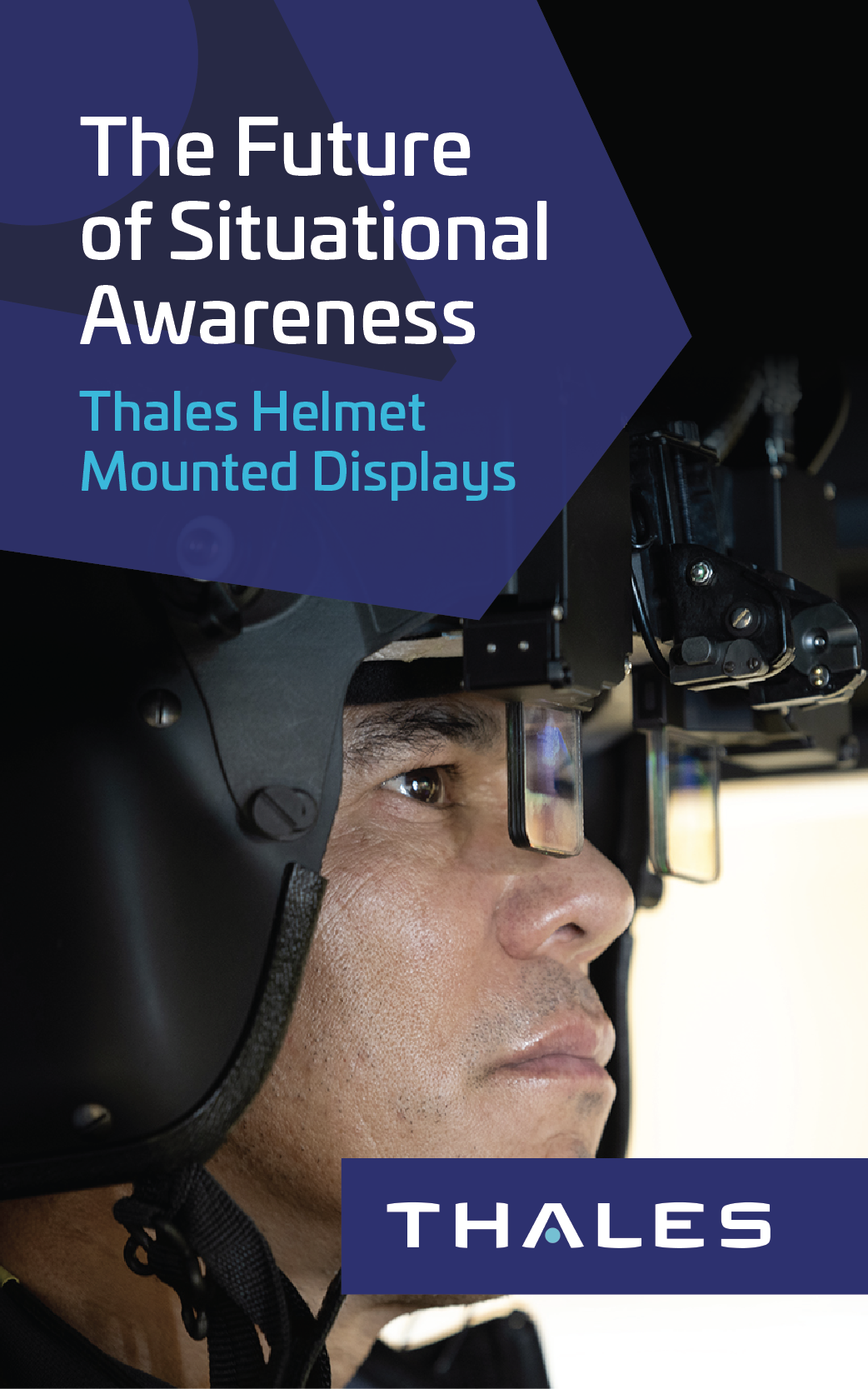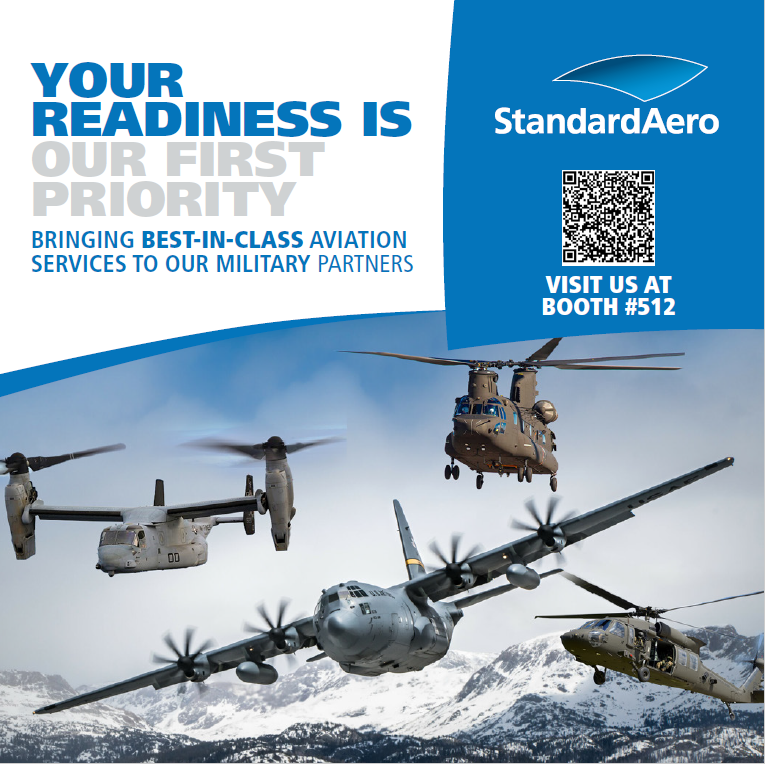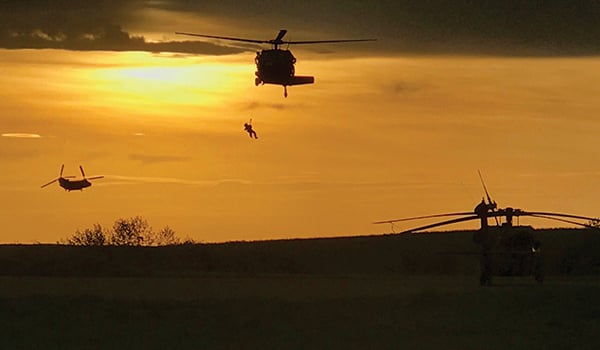
From the Field / By LTC David L. Magness: With the last ember of daylight on a cool Canadian spring night, American infantrymen lay prone in their fighting positions. Mosquitos had come out in earnest during the almost two hour long sunset, and the ground was soaked by three days of rain. Soldiers manning their posts strain to see or hear any sign of the enemy. The buzzing of insects is soon replaced by the distant but all too familiar whoop of CH-146 Griffon helicopters.

Sun sets at Airfield 21, Wainright, Canada, as C/1-169th MEDEVAC conducts live hoist operations while a CH-147 turns base for landing. / U.S. ARMY PHOTOS
Griffons, similar to the UH-1 helicopters of Vietnam, echoed louder and louder. The Royal Canadian Air Force (RCAF) RECCE (recon) aircraft expertly bounded in over-watch movements, edging closer to the Forward Line of Troops (FLOT); the pilots careful to not silhouette themselves in the night sky. The Griffon’s weapon systems and gunners primed for a fight, and the infantry on the ground stirred in quiet anticipation.
An RCAF Major, the Air Mission Commander (AMC), makes secure radio contact with the infantry commander. They exchange few words, but the intent is clear, “friendlies approaching – weapons tight.” Griffon pilots use their MX-15 Forward Looking Infrared (FLIR) to search the foliage for heat signatures. Friendly troops can be seen arrayed defensively around the LZ and the Griffons assume over-watching positions over the avenues of high speed approach. With the CH-146s in position, the area is secured and the brevity code “Ice” is announced.
It’s a common code word that is used by both Canadian and American forces. It’s a blessing to the Air Task Force commander’s ears – no enemy presence at the LZ and the air mobile would be unopposed. Three RCAF CH-147F Chinooks followed by two Maryland Army National Guard (MDARNG) UH-60L Black Hawks fly out of their holding area a few kilometers from the FLOT.
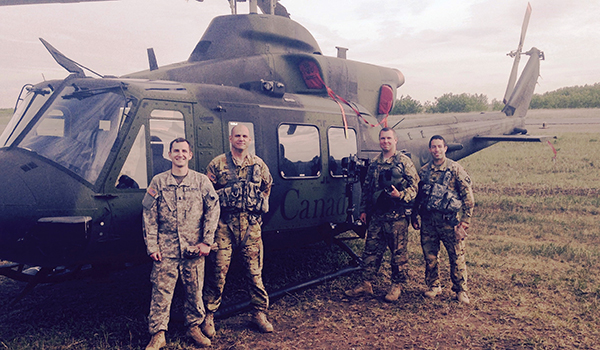
(l to r) 1LT Stephen Sauve, LTC Dave Magness, CPT Mark Chambers, and CPT Mark Zinderman pose near a Canadian CH-146 Griffon helicopter.MD
More than 100 Canadian, British, and New Zealand infantry soldiers, augmented by small vehicles and supplies, are crammed into the dark and noisy aircraft. A crew chief wearing Night Vision Goggles (NVGs) occasionally glanced back at his passengers and sees a wide range of facial features and emotions. Some of the soldiers are excited, others mildly showing signs of air sickness, and a few are even sleeping.
The eyes of the RCAF flight crews are lit with the blue green light of their ANVIS-9 NVGs as they fly above the Alberta Canadian wilderness. The MDARNG UH-60Ls follow in serial two, separated by about 200 feet. The flight of five helicopters passes herds of bison and cattle that barely take notice. The UH-60 flight crews watch with their ANVIS 6 NVGs as the Chinooks pass their Initial Approach (IA) Air Coordination Point (ACP) and reform into an echelon right formation. The UH-60s similarly move to a stagger right formation.
Similar But Different
This event was a microcosm of the Canadian Joint Allied Training Center exercise known as Maple Resolve. The landscape, equipment, and soldiers that led the event were consistently similar to their American allies, but distinctly different, and uniquely Canadian.
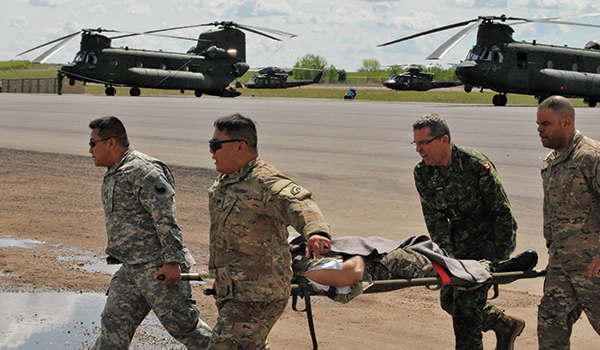
Soldiers scramble during a MASCAL exercise at Airfield 21, Wainright, Canada.
Maple Resolve 2017 is a Canadian Manoeuvre (Maneuver) Training Centre (Center) (CMTC) exercise that utilizes armed forces across the North Atlantic Treaty Organization (NATO) and the Commonwealth. American, British, French, Australian and New Zealand soldiers, to name a few, participated. While the event is named a Training Center event, the typical U.S. Army Staff images of NTC, JRTC, and War-fighter would not develop a completely accurate picture. Although very similar in execution and almost indistinguishable at the company level, the planning phase objectives are very different.
The CMTC plans team focuses on validation of Canadian Forces in what the U.S. Army would consider their “Ready/Available” year and is very similar to what the Guard and Reserves conduct at mob validation. The Canadians do not focus on the War Fight, to include the months of Military Decision Making Process (MDMP) that every U.S. Army staff officer has enjoyed prior to an exercise. They focus on “injects” or training scenarios.
Under Objective T, this exercise has tremendous potential for validating units. An Army aviation company can easily provide their Mission Essential Task List (METL) and work with Canadian planners on a way to maximize their training needs.
Additional Training Resources
The Canadians provided additional resources at the CMTC that have made training easy, fun, and realistic. They contracted a civilian actor/special effects company that has appeared in several mainstream TV shows. Actors include real world amputees (many war veterans) that were fitted with special effect prosthetics that simulated exposed bone, amputations, and an assortment of grizzly but real world casualties. Additionally, the company had unique battlefield smells that were used to desensitize soldiers to the horrors of war.
MDARNG C/1-169 MEDEVAC company commander, CPT Mark Zinderman, capitalized on this resource. He scheduled an assortment of medical injects to include a mass casualty (MASCAL), hoist operations, and other paramedic training requirements. Coupled with a real world “No Duff” (not a drill or exercise) MEDEVAC mission, C/1-169 and Canadian Health Service Support (HSS) discovered several standardization issues with lines of communication, processes and terminology. Several rehearsals were conducted to streamline the MEDEVAC effort. After Action Reviews (AARs) identified issues that included differences in nine line versions and use of terms like Category (CAT) A Point of Injury (POI) verses CAT A patient transfers.
Spotlighting Differences
Maple Resolve spotlighted an assortment of Allied communication, doctrinal, and equipment differences. This included the standardization of names. In American forces, the C in CH-47F stands for Cargo while the CH-147F stands for Canadian. The RCAF emphasize UHF frequencies versus FM. The Multi-Functional Display (MFD) CH-47F vertical data strips showing engine and transmission performance are replaced by CH-147F digitally displayed “steam/radial” gauges. The incorporation of the MX-15 FLIR and a host of other changes only demonstrate the subtle, while still substantial differences.
U.S. Assets
MDARNG supplied not only the MEDEVAC assets, but a battalion headquarters, 1-224th Security and Support (S&S) and an Assault Helicopter Company (AHC). CPT Timothy Swenson, C/2-224 AHC commander, focused his efforts on the air mobile; a term used interchangeably by the Canadians to describe both air movement and air assault operations. The 450th RCAF Tactical Helicopter Squadron (THS) and the 1-224th S&S Battalion worked jointly on both PTA (Blue Force) and OPFOR missions nightly due to mission requirements. A total of four air mobiles were conducted. The running joke became that aviation elements were mercenaries for hire.
CPT Swenson dealt with an assortment of issues to include non-standard terms. His RCAF counterparts primarily used NATO terminology and developed several Tactics Techniques and Procedures (TTPs) from other NATO countries to include the Commonwealth. One example included CH-147Fs leading spiral down descents under NVGs to lose altitude prior to entering the “box”. This unused and unheard of technique in U.S. Army aviation was a serious concern when it was being initiated with MDARNG aircraft following in formation. The use of a liaison officer (LNO) that rode with the RCAF AMC aircraft, and his counterpart in the MDARNG assault AMC aircraft, was critical in deconflicting the issue.
An American two point Forward Arming Refuel Point (FARP) was augmented by the larger Canadian refuel tankers. It was discovered onsite that the CH-147Fs carried twice the fuel load of an American CH-47F. This frustrated the meticulous battalion S4 planners. Another on the spot discovery that led to confusion in the FARP was Canadian Flight Engineers/Crew Chiefs refueling their aircraft instead of U.S. Army 92F MOS refuelers.
Summary
Overall, the operation highlighted the inherent communication, sustainment, and training issues for Allied and Joint Unified Land Operations. It was an eye opening experience that was extremely enjoyable and educational. The use of Maple Resolve to improve unit readiness in accordance with Objective T is mutually beneficially to Canadian and American armed forces.
LTC David L. Magness is the commander of 1st Battalion, 224th Aviation Regiment, Maryland Army National Guard based out of Aberdeen Proving Ground,













